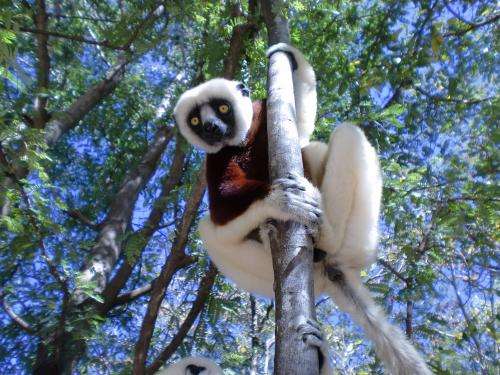Finding how many Coquerel's sifaka exist

In a study now published in the American Journal of Primatology, Célia Kun-Rodrigues and Jordi Salmona, from Lounès Chikhi's laboratory at the Instituto Gulbenkian de Ciência (IGC) provide the first abundance estimates of Coquerel's sifaka (Propithecus coquereli), an endangered lemur species, in its last main refugium, the Ankarafantsika National Park (ANP) in Madagascar.
Madagascar is one of the hottest biodiversity hotspots, well known for the diverse species of lemurs living there. The Coquerel's sifaka is one of the lemur species that has been classified by the International Union for Conservation of Nature (IUCN) as an "endangered" species.
Despite this status, no reliable population density or abundance estimates were available until now that could be used in the planning of conservation strategies. It has been known that Coquerel's sifaka survives in small areas of the highly fragmented forests, and in the ANP, the largest forested area in northwest Madagascar with about 1000 km2.
The fieldwork developed in the ANP allowed Kun-Rodrigues and Salmona to determine that the density of the Coquerel's sifaka population was dramatically different among the surveyed sites, varying from 5 to 100 individual per km2. Sites closer to rivers have a higher density, whereas those closer to roads and forest edges present a lower number of sikafas. Furthermore, the researchers observed a major decline of the population in the last 20 to 30 years, reaching a decrease of more than 90 percent in at least one spot of the park. It is difficult to estimate the number of individuals of Coquerel's sifaka living in the ANP since densities appear to vary widely across the park. But a preliminary estimation of the total population size in the ANP made by the researchers indicates approximately 47,000 individuals. Habitat loss and poaching are probably the major factors that contribute to this species decline.
Lounès Chikhi says, "We believe that conservation actions are required at the community level but also at a wider geographical scales to reduce charcoal consumption in nearby towns and deforestation fueled by foreign demands."
Jordi Salmona adds: "If nothing is done to protect Coquerel's sifaka, low densities such as 5 to 10 individuals per square kilometer may extend to the whole ANP. This would mean that in the next decade or two, a population of just 5,000 individuals could be reached."
More information: Kun-Rodrigues, C, Salmona, J, Besolo, A, Rasolondraibe, E, Rabarivola, C, Marques, T, Chikhi, L. (2014) New Density Estimates of a Threatened Sifaka Species (Propithecus coquereli) in Ankarafantsika National Park. Am. J. Primatol. Jan 17 [Epub ahead of print] DOI: 10.1002/ajp.22243
Journal information: American Journal of Primatology
Provided by Instituto Gulbenkian de Ciencia



















